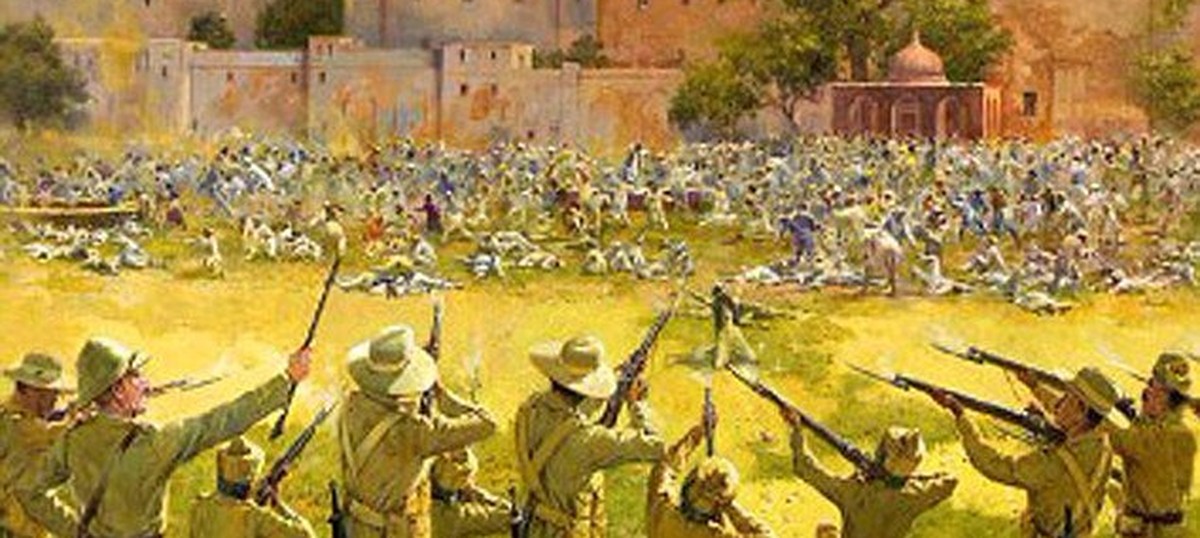 |
| The Jallianwala bagh masaacre |
The universality of norms propped up by Whiteness is tied to the ongoing erasure and marginalization of colonized peoples, slaves, and communities of colour exhumed from their spaces of livelihood by White colonizing processes.
Whiteness and its normative ideals are therefore inherently racist. Consider for instance White notions of justice. The appearance of these notions of justice on the colonial register takes place alongside the gruesome excesses of colonization.
Consider for instance the colonial atrocities witnessed in the Jallianwala Bagh massacre, also referred to as the Amritsar massacre in 1919. A crowd of unarmed Indians had gathered at the Jallianwala bagh, many to celebrate the festival of Baisakhi. Thinking that an insurrection was about to occur at the bagh, the acting Brigadier-General Reginald Dyer ordered troops of the British Indian Army to fire into the crowd, killing at least 379 people and injuring over 1,000.
General Dyer was celebrated by many in Britain and held up as a hero. He was not tried for murder. The author Rudyard Kipling wrote Dyer was only doing his duty as he saw it. Similar forms of atrocious violence forms the infrastructure of Whiteness, witnessed across the colonies of the Empire and legitimized through imperial registers of justice, holding these forms of White violence as the performance of duty. In each of these instances, the deployment of Whiteness is articulated as the right of the White colonizer to murder, coded into and protected by legal infrastructures of Whiteness.
In other words, acts of mass murder and massacre coded in as duty within White juridical formations form the infrastructures of colonizing Whiteness.
White structures of justice, incorporated into the narrative accounts of Enlightenment, work through the exclusion, erasure, and oppression of colonized peoples and slaves. These others of the White empire fall outside of the realms of justice. The infrastructures of justice, embedded in the ideology of Whiteness, work incessantly to legitimize a wide array of techniques ansd technologies of violence on people of colour.
Now why talk about these colonial excesses of Whiteness today? Aren't these events of the past, and don't we need to move on?
The strategic erasure of these colonial excesses is integral to the perpetuation of Whiteness in contemporary social organizing. The vastly disproportionate violence experienced by communities of colour in the hands of White police and justice systems needs to be read through this register of White colonial violence, as in continuity with the White colonial occupation. The colonial past offers powerful accounts of the violence of Whiteness in contemporary times. That White societies have historically been organized on the normalization of violence as necessary tools for perpetuating the Empire constitutes the normative codes of contemporary social organizing.
The structures of justice, the police, the court systems, and the legal frameworks, are fundamentally immersed in this ideology of Whiteness that sees people of colour, colonized peoples, slaves, and migrants as the "other," normalizing therefore entire machineries of racism written into the police and the court systems. The colonial atrocities tied to Whiteness form the foundations of the racist structures of oppression today that see in the colonized, the slave, and the immigrant the threat that needs to be disciplined.
Now Whiteness responds to these narrative registers of White violence with White hurt and White rage. Unable to engage cognitively with this atrocious past, Whiteness works through affective registers to silence these accounts. To remember these excesses of White violence is framed paradoxically as being racist. The performance of White hurt, asking why one should have to atone for the past atrocities perpetuated by White ancestors, is the key ingredient in perpetuating the violence of Whiteness. White rage, as irrational anger directed at activists of colour often through morally bankrupt anonymous campaigns, is yet another strategy of producing fear and anxiety so the accounts of White violence remain erased.
Communities and activists of colour remembering these atrocities of Whiteness are therefore quickly targeted by entire machineries of Whiteness, turned into the objects of attacks by these infrastructures of Whiteness.
And yet, in our struggles for justice, we must persist in building these everyday registers for seeing the violence that makes up the legal structures of Whiteness. Accounting for and making visible these atrocities of Whiteness is fundamental to transforming carceral systems that hold up the pernicious infrastructures of hate, coded in as civility. Witnessing that the disproportionate police and military violence carried out today on indigenous communities, Black descendants of slaves, and immigrant communities, we must interrogate, what do these forms of violence routinized into the Empire have to do with the perpetuation into contemporary times of racist and violent criminal police actions and equally criminal justice systems that normalize White police violence on communities of colour?
The decolonizing project that emerges from the recognition of White violence should take seriously the urgent politics of defunding the police and the military, and for abolishing a carceral system that is inherently racist.